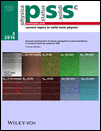Near ambient pressure photoemission spectroscopy of metal and semiconductor surfaces
Abstract
We describe a novel photoemission technique utilizing a traditional Kelvin probe as a detector of electrons/atmospheric ions ejected from metal and semiconductor surfaces (Al, Ag, Au, Si) illuminated by a Deep Ultra-Violet (DUV) source at ambient pressure. In Constant Final State Yield Spectroscopy (CFSYS) the incident photon energy is rastered rather than applying a variable retarding electric field as in conventional UPS. For both ambient- and near ambient pressure-photoemission spectroscopy (NAP-PES) the CFSYS configuration overcomes the limitation of inelastic electron scattering in air. This arrangement can be applied in several operational modes: using the DUV source to determine the absolute work function (ϕ) of the metal with 50-100 meV resolution and also the Kelvin probe, under dark conditions, to measure Contact Potential Difference (CPD) with an accuracy of 1-3 meV. We show that the metal photoresponse agrees with Fowler theory. We have used CPD and linear extrapolated photoemission measurements to produce an energy level diagram for the native-oxide covered Si. We propose a model of photoemission in air involving atmospheric ions. (© 2015 WILEY-VCH Verlag GmbH & Co. KGaA, Weinheim)




